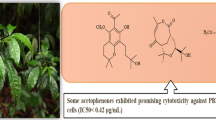Abstract
Ten caffeic acid derivatives (1–10) were isolated from the roots of Salvia miltiorrhiza by using various chromatographic methods and their chemical structures were spectroscopically elucidated. The absolute configurations of chiral centers were determined by comparison with reported coupling constants, optical rotation values, and CD techniques. Anti-inflammatory activities were evaluated using nitric oxide (NO), inducible nitric oxide synthase (iNOS), cyclooxygenase (COX)-2 inhibition assays, and by determining the expression of heme oxygenase (HO)-1. Two new caffeic acid derivatives, 8-epiblechnic acid 9-methyl ester (4) and 8-epiblechnic acid 9′-methyl ester (5), and eight known derivatives, caffeic acid methyl ester (1), shimobashiric acid B (2), rosmarinic acid methyl ester (3), salvianolic acid C (6), methyl salvianolate C (7), lithospermic acid monomethyl ester (8), lithospermic acid dimethyl ester (9), and dimethyl lithospermate B (10), were isolated from the ethyl acetate fraction of S. miltiorrhiza. All caffeic acid derivatives were evaluated for their inhibitory effect on NO production. Compounds 2 and 3 inhibited NO production with IC50 values of 1.4 and 0.6 μM, respectively. These compounds also strongly inhibited the production of iNOS and COX-2. In addition, compound 3 induced the expression HO-1 in a concentration-dependent manner at 0.1, 0.3, and 1.0 μM.




Similar content being viewed by others
Change history
19 November 2018
The author would like to include conflict of interest statement of the online published article. The correct conflict of interest statement should read as:
Conflict of interest
The authors declare no conflict of interest.
19 November 2018
The author would like to include conflict of interest statement of the online published article. The correct conflict of interest statement should read as:
References
Ai CB, Li LN (1988) Stereostructure of salvianolic acid B and isolation of salvianolic acid C from Salvia miltiorrhiza. J Nat Prod 51:145–149
Amoah SK, Sandjo LP, Kratz JM, Biavatti MW (2016) Rosmarinic acid-pharmaceutical and clinical aspects. Planta Med 82:388–406
Chang SW, Kim KH, Lee IL, Choi SU, Ryu SY, Lee KR (2009) Phytochemical constituents of Bistorta manshuriensis. Nat Prod Sci 15:234–240
Jang SI, Jeong SI, Kim KJ, Kim HJ, Yu HH, Park R, Kim HM, You YO (2003) Tanshinone IIA from Salvia miltiorrhiza inhibits inducible nitric oxide synthase expression and production of TNF-α, IL-1β and IL-6 in activated RAW 264.7 cells. Planta Med 69:1057–1059
Jin HZ, Hwang BY, Kim HS, Lee JH, Kim YH, Lee JJ (2002) Antiinflammatory constituents of Celastrus orbiculatus inhibit the NF-kappaB activation and NO production. J Nat Prod 65:89–91
Kang HS, Chung HY, Jung JH, Kang SS (1997) Antioxidiant effects from Salvia miltiorrhiza. Arch Pharm Res 20:496–500
Kim JK (1989) Illustrated natural drugs encyclopedia. Namsandan Publishers, Seoul
Lee DS, Lee SH, Noh JG, Hong SD (1999) Antibacterial activities of cryptotanshinone and dihydrotanshinone I from a medicinal herb, Salvia miltiorrhiza Bunge. Biosci Biotechnol Biochem 63:2236–2239
Lee J, Tae N, Lee JJ, Kim T, Lee JH (2010) Eupatolide inhibits lipopolysaccharide-induced COX-2 and iNOS expression in RAW264.7 cells by inducing proteasomal degradation of TRAF6. Eur J Pharmacol 636:173–180
Li X, Tang YH, Zhao XF, Lu HB, Zheng XH (2004) Active components in the extracts of Radix Salvia miltiorrhizae by supercritical carbon dioxide fluid. Acad J Xian Jiaotong Univ 25:614–620
Ma S, Zhang D, Lou H, Sun L, Ji J (2016) Evaluation of the anti-inflammatory activities of tanshinones isolated from Salvia miltiorrhiza var. alba roots in THP-1 macrophages. J Ethnopharmacol 21:193–199
Murata T, Miyase T, Yoshizaki F (2012) Hyaluronidase inhibitors from Keiskea japonica. Chem Pharm Bull 60:121–128
Nguyen HD, Choo YY, Nguyen TD, Nguyen HN, Chau VM, Lee JH (2016) Malabaricone C inhibits PDGF-induced proliferation and migration of aortic smooth muscle cells through induction of heme oxygenase-1. J Cell Biochem 117:659–670
Park JW, Lee SH, Yang MK, Lee JJ, Song MJ, Ryu SY, Chung HJ, Won HS, Lee CS, Kwon SH, Yun YP, Choi WS, Shin HS (2008) 15,16-Dihydrotanshinone I, a major component from Salvia miltiorrhiza Bunge (Dansham), inhibits rabbit platelet aggregation by suppressing intracellular calcium mobilization. Arch Pharm Res 31:47–53
Sun Z, Zheng Q, Ma G, Zhang X, Yuan J, Wu H, Liu H, Yang J, Xu X (2014) Four new phenolic acids from Clerodendranthus spicatus. Phytochem Lett 8:16–21
Tanaka T, Morimoto S, Nonaka GI, Nishioka I, Yokozawa T, Chung HU, Oura H (1989) Magnesium and ammonium-potassium lithospermates B, the active principles having a uremia-preventive effect from Salvia miltiorrhiza. Chem Pharm Bull 37:340–344
Terry CM, Clikeman JA, Hoidal JR, Callahan KS (1998) Effect of tumor necrosis factor-alpha and interleukin-1 alpha on heme oxygenase-1 expression in human endothelial cells. Am J Physiol 274:883–891
Wada H, Kido T, Tanaka N, Murakami T, Saiki Y, Chen CM (1992) Chemical and chemotaxonomical studies of ferns. LXXXI. Characteristic lignans of Blechnaceous Ferns. Chem Pharm Bull 40:2099–2101
Wu Z, Ouyang M, Yang C (1998) Polyphenolic constituents of Salvia przewalskii. Acta Bot Yunnan 21:512–516
Yu Y, Wang YR, Dong ZH, Li W, Li SM, Huang XF (2017) New phenolic acids from Salvia yunnanensis CH Wright. Nat Prod Res 18:1–8
Zhang Y, Li X, Wang Z (2010) Antioxidant activities of leaf extract of Salvia miltiorrhiza Bunge and related phenolic constituents. Food Chem Toxicol 48:2656–2662
Zhao J, Lou J, Mou Y, Li P, Wu J, Zhou L (2011) Diterpenoid tanshinones and phenolic acids from cultured hairy roots of Salvia miltiorrhiza Bunge and their antimicrobial activities. Molecules 16:2259–2267
Acknowledgements
This research was supported by the National Research Foundation of Korea (NRF) funded by the Ministry of Science, ICT, and Future Planning (NRF-2015M3A9A5031271).
Author information
Authors and Affiliations
Corresponding author
Electronic supplementary material
Below is the link to the electronic supplementary material.
Rights and permissions
About this article
Cite this article
Choi, H.G., Tran, P.T., Lee, JH. et al. Anti-inflammatory activity of caffeic acid derivatives isolated from the roots of Salvia miltiorrhiza Bunge. Arch. Pharm. Res. 41, 64–70 (2018). https://doi.org/10.1007/s12272-017-0983-1
Received:
Accepted:
Published:
Issue Date:
DOI: https://doi.org/10.1007/s12272-017-0983-1




